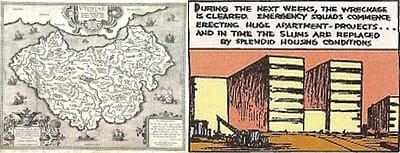Superheroes & the Modern City
Star Wars Modern has posted an extensive essay on the evolution of American superheroes, particularly Batman and Superman, and their relationship to modernity and urbanism. His post incorporates many figures that loom large in the 20th C. American urban imagination and he focuses mainly on pop cultu

Star Wars Modern has posted an extensive essay on the evolution of American superheroes, particularly Batman and Superman, and their relationship to modernity and urbanism.
His post incorporates many real-life figures that loom large in the 20th C. American urban imagination (Jane Jacobs, Robert Moses … ) and he focuses mainly on pop culture as a barometer of changing public attitudes. The essay, titled “The Urbanism of Superheroes,” careens across many ideas and suggests there is more that binds these seemingly disparate things than may be evident at first glance:
Explosive urban growth is modernity. Utopia is to urban growth as industrial agriculture is to wild growth. Utopia is the expression of an anti-urbanist bias; a desire to tame cities; to rationalize and control their growth; to impose moral order. Rem Koolhaas calls the explosive urbanism of early 20th Century Manhattan a “culture of congestion” and blames European modernism for “lobotomizing” the “Capital of Perpetual Crisis.” In a nice bit of post-war symmetry, the Situationist International idealized the confounding and compressed center of the old Ville de Paris, defending it against a brand of modernist development widely seen as American, and prompting Raul Vaneigem to proclaim:
Our position is that of combatants between two worlds – one that we don’t acknowledge, the other that does not yet exist.
These are the same forces that denuded Superman and turned him into a creature of the establishment, and justified Batman’s uncompromising violence. If squatter cities are indeed the world of tomorrow, one is left to wonder what a feral superman would fight for, how he would fight, what he would fight against, and what kind of city it would take to support him.
It’s so wonderful to read such a lucid discussion by a blogger, who is comfortable in so many worlds (art, pop culture, architecture, literature, theory …) and able to weave together interesting arguments that help illuminate the world around us.





